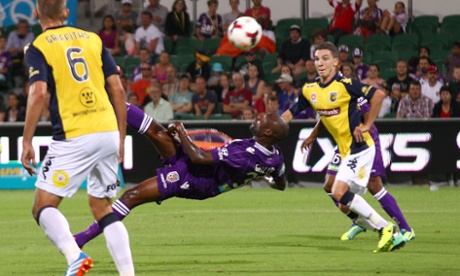
For the second time this season we’ve had the chance to examine a new man step in to replace a departed coach. Given that both Kevin Muscat and Phil Moss have replaced two of the best coaches in the league, it’s unremarkable that both promoted assistants have chosen to continue the style and systems of their predecessors.
Against Perth, the Central Coast Mariners therefore set up in the 4-2-3-1 system they’ve played all season. There was however one change made by Moss that set tongues wagging. Brent Griffiths – a peripheral figure all season – suddenly leap-frogged both Zac Anderson and Dutch veteran Marcel Seip in the pecking order to fill the left centre-back position. And while it’s tempting to presume this is a reflection on either of these two, the reality is that it had less to do with them – and more to do with Michael McGlinchey.
The ‘False Eleven’
We’ve seen over recent seasons that with the National Curriculum’s emphasis on ‘playing out from the back’ just how much the role of full-backs has transformed in the A-League. In recent weeks this column has documented how Sydney FC has adapted to utilise Pedj Bojic as an attacking threat, as well as how the Wanderer’s system aims to cash in on the crossing ability of Jerome Polenz.
To maximise the attacking potential of a gifted full-back however requires an adjustment of the role of the wingers in front of them – and increasingly teams are looking not to out-and-out wingers, but to attacking-midfielders masquerading as wingers. Thomas Broich at Brisbane has been perhaps the best example of this, alongside McGlinchey.
Contrast the positions taken up by McGlinchey with his rival left-winger and gas-merchant Sidney Sciola.
The positional adjustment by McGlinchey had a series of ramifications – not just for the surrounding Perth Glory players, but for his own side as well; Josh Rose most notably. Cameron Edwards, playing the No8 role for Perth was often dragged deeper to cover McGlinchey, especially when overlapping runs from Rose had tied up the Perth right full-back Davies. With Edwards being pulled out of position, Central Coast were able to edge the midfield battle – they had 57% possession away from home, with the two holding midfielders, Hutchinson and Caceres making 130 successful passes, compared with Edwards, Edwards and Burns, who compiled one-third less (82).
With Central Coast controlling midfield it allowed Rose to push higher up the park, thus neutralising the attacking threat of Nagai, who was forced to track back with his full-back. It’s no coincidence the Japanese had little influence on the match and was substituted just after the hour mark.
Whilst there’s no doubt the injury to marquee defender William Gallas changed the complexion of the match – the vastly-experienced France international leaving the field just minutes before McGlinchey’s strike – it was the positional adjustment of the diminutive New Zealander that was key to the Central Coast’s opener.
With Flores over the ball and the Perth defence retreating, had McGlinchey taken up a routine winger’s position the ball never would have broken to him. Yes, there was a slice of luck in the fact that Thwaite’s half-clearance went straight to his feet, but on such small margins football games turn.
So how does this all relate to Griffiths?
Moss told reporters during the week he preferred the presence of a left-footed left centre-back due to the greater passing range that this affords. Looking at Central Coast’s passing combinations there was an evident left-sided bias – eight of the 10 most common passes played throughout the entire game were between the left-sided quarter of Griffiths, Rose, Hutchinson and McGlinchey; and looking at Liam Reddy’s distribution, when building attacks from the back the Central Coast ‘keeper found Brent Griffiths on almost twice as many occasions as he did any other player.
Whether this left-sided focus was a deliberate strategy to target the combination of Nagai and Davies, only Moss can clarify. The fact remains that courtesy a heavy left-sided passing bias, the Mariners were able to maximise both McGlinchey and Rose as attacking threats, and it was no coincidence that the two reveled in the space created.

